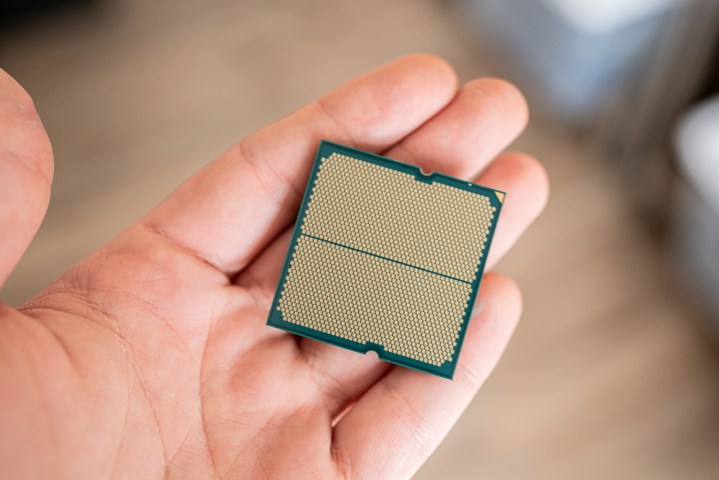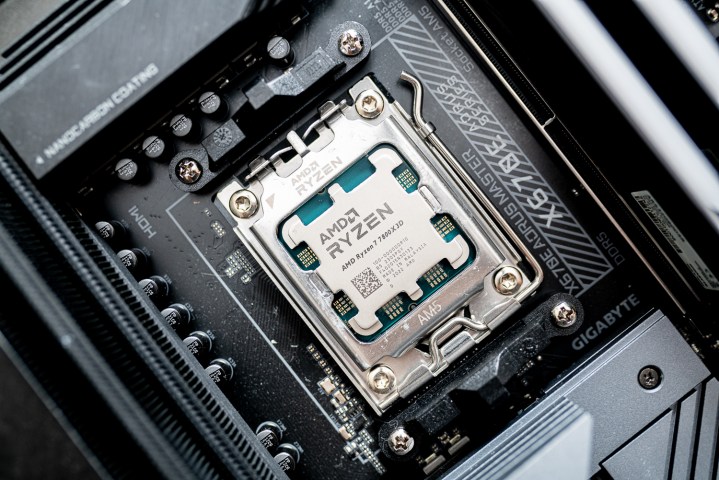
AMD has three high-end 3D V-Cache chips out in this generation, but only one stands out like a sore thumb. There’s the flagship Ryzen 9 7950X3D. There’s also the best gaming CPU, the Ryzen 7 7800X3D. And then, there’s the often overlooked middle child — the Ryzen 9 7900X3D.
While it may seem like an upgrade from the Ryzen 7 alternative, the Ryzen 9 7900X3D is a little bit deceptive in that regard. Here’s why you’d be better off going for the Ryzen 7 7800X3D.
A twist on 3D V-Cache
Understandably, most people would also assume that the 7900X3D should show a marked improvement over the 7800X3D. However, most benchmarks will tell you that is not the case, and the underlying cause lies in the architecture of the chip.
Let’s start with a quick explainer on 3D V-Cache itself. First debuted in the highly successful Ryzen 7 5800X3D, AMD’s 3D V-Cache tech stacks an extra L3 cache chiplet directly on top of the processor’s core complex die (CCD). Zen 4 CCDs have an on-die L3 cache of their own, so this 3D V-Cache is connected using through-silicon vias (TSVs). This effectively triples the L3 cache available to the CPU cores without significantly increasing the footprint of the chip.
Using 3D V-Cache gives AMD chips many benefits in gaming scenarios. Games that frequently access large data sets see a huge performance boost due to the faster and larger cache, as well as reduced latency. X3D processors also typically consume less power; for instance, the 7900X3D has a TDP of 120 watts, while its non-3D counterpart bumps that up to 170W.

On the other hand, there are a couple of downsides. AMD CPUs from the X3D lineup don’t support much overclocking and have a lower thermal limit than their non-3D siblings. They require capable coolers — watercoolers, really — and maintain lower clock speeds. Despite that, the 128MB of L3 cache that the Ryzen 9 7900X3D sports (64MB of which comes from the 3D V-Cache while the other 64MB accounts for on-die cache) would have set it up for success, but one of AMD’s design choices made this a controversial entry in the lineup.
It all comes down to the fact that the Ryzen 9 7900X3D is a dual-CCD CPU, meaning it has two CCDs, each with six cores, but AMD only equipped one of them with the 3D V-Cache. This means that only six out of its 12 cores can access all that extra L3 cache that has been proven to deliver a huge boost in gaming.
AMD explained this design choice in a blog post. Basically, AMD found that the benefits of only equipping one die with the extra cache outweighed the cons. One die sports the extra cache, but the other makes up for the lack of it with higher clock speeds. Scaling back to just one die with the 3D V-Cache helps AMD lower manufacturing costs without affecting the performance too much.
This does mean that the 7900X3D is at a disadvantage compared to the other two chips in this generation, though. AMD’s best CPU, the 7950X3D, also comes with two CCDs, but each sports eight core, which means that eight cores get the 3D V-Cache and eight don’t. Meanwhile, the Ryzen 7 7800X3D only has one CCD and a total of eight cores, all of which can access the extra cache.
In theory, this should have made the Ryzen 9 7900X3D the better chip for both gaming and productivity. However, benchmarks prove that theory can often be far removed from reality.
The numbers don’t add up

When you buy a CPU — or almost any PC component, really — the two most important points of consideration are its performance and its price. Put that together and you start thinking of performance per dollar, which AMD typically excels at compared to Intel, although your mileage may vary in high-end processors.
The issue with the Ryzen 9 7900X3D is that its performance doesn’t justify its cost, and that’s despite the price cuts it received since its launch.
First, a quick recap of the pricing for the 7950X3D, the 7900X3D, and the 7800X3D. The Ryzen 9 7950X3D launched at a recommended list price (MSRP) of $700, but can now be bought for $583. The Ryzen 9 7900X3D followed at just $100 less, meaning a $600 MSRP, and has since dropped down to $393. Lastly, the Ryzen 7 7800X3D used to cost $450, but it now sells for $370 or less.
The initial price gap between the 7900X3D and the 7800X3D was a much bigger issue than it is now, but still, the performance needed to justify it just isn’t quite there. Even now, the 7800X3D remains a better choice for pure gaming, and to prove it, we’ll compare it to the flagship 7950X3D.

In our own testing of the 7950X3D and the 7800X3D, we found the chips trade blows in gaming. This makes sense, as the way AMD distributes the extra cache makes them equal, with both sporting eight cores with the same amount of cache. Of course, the 7950X3D pulls miles ahead in productivity — after all, it has a total of 16 cores while the 7800X3D is limited to eight.
On average, the Ryzen 7 7800X3D fell within 1%t of the Ryzen 9 7950X3D across our entire test suite of games at 1080p resolution. It also outperformed the Intel Core i9-13900K, a CPU that costs significantly more, sports a higher core count, and eats electricity like it’s candy. There are some games where the flagship AMD chip takes the lead, such as Gears Tactics, but in F1 2022, the Ryzen 7 7800X3D shoots ahead, hitting 400 frames per second (fps), whereas the Ryzen 9 7950X3D is limited to 379 fps.
With that out of the way, let’s zoom in on the 7900X3D. Although we don’t have any benchmarks of our own on hand, it’s easy to imagine that if the 7800X3D can outperform the 7950X3D, and at the very least can keep up with it, the scenario repeats itself with the 7900X3D. Benchmarks from many publications support this assumption. For instance, in testing performed by Tom’s Hardware, the 7800X3D tops the list with 224 fps on average, followed by the 7950X3D with 222 fps, while the 7900X3D trails behind at 212 fps.
So, we’re looking at two chips that are very close in gaming performance, except the Ryzen 7 7800X3D is cheaper and is currently the world’s fastest gaming CPU.
Now, to give you the full picture, I will admit that the Ryzen 9 7900X3D wins in productivity — often by a significant margin. However, if productivity is what you’re after, it’s not the 7900X3D that you should be buying … and if you’re into pure gaming, the 7900X3D is also not it.
Only worth it on paper

The Ryzen 9 7900X3D is a strange entry in AMD’s Zen 4 lineup. Its design almost dooms it to be a product that’s neither here nor there, and that’s why it’s a subpar pick for gaming, and also not the best pick for work.
Sure, some games don’t need all of the eight cores provided by the 7800X3D (and the 7950X3D) — but some of them do, in which case the 7900X3D falls behind, because it can never run more than six cores with all that extra cache. It just wasn’t built to work that way, and that’s why the 7800X3D, while “worse” on paper, pulls ahead in most scenarios.
I’m not saying that the Ryzen 9 7900X3D is massively slower than its siblings in gaming, because it’s not. The problem is that it’s not faster than the cheaper alternative, and with 12 cores instead of 16, it’s also not the best option if you’re looking for a mix of gaming and resource-heavy workloads, like rendering and encoding.
You might be thinking that those four extra cores could be nice for basic productivity, and while having them won’t hurt, most of us don’t need them. I was faced with the same choice just last year. I’m a gamer, but I also use my PC to work. I decided to buy the 7800X3D because my work is limited to running basic software and a bazillion browser tabs at once. If your workloads resemble mine, you don’t need the 7900X3D, and you’ll be just fine with the 7800X3D.
If heavy productivity is what you’re after, you’re probably better off skipping the X3D chip altogether and going for an Intel CPU, such as the Core i7-13700K or the Core i9-13900K. Alternatively, save up and get the Ryzen 9 7950X3D, which is significantly faster than the Ryzen 9 7900X3D.
This leaves the Ryzen 9 7900X3D in a strange place. Despite multiple cuts that reduced its price by over $210, there’s still no niche for it. Less capable than both its siblings and still not cheap enough, it’s the ultimate CPU to skip in this generation — so if you’re a gamer, you don’t need to hesitate if you’re gravitating toward the Ryzen 7 7800X3D.
Editors' Recommendations
- 4 CPUs you should buy instead of the Ryzen 7 7800X3D
- The gamers have spoken: AMD obliterates Intel in CPU sales
- These two CPUs are the only ones you should care about in 2023
- AMD’s upcoming Ryzen 5 5600X3D could completely dethrone Intel in budget builds
- Some Ryzen CPUs are burning up. Here’s what you can do to save yours



